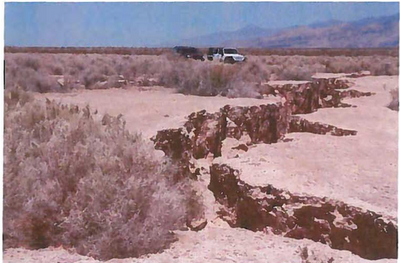BrightSource Energy's Plans to Limit Environmental Review Meets Resistance
In an odd legal move, BrightSource Energy is demanding the California Energy Commission (CEC) correct "errors" in the preliminary staff assessment of the company's Hidden Hills solar project. BrightSource's motion to alter the staff assessment would limit environmental analysis in such a way that improves the company's chances of approval, despite serious concerns about the project's water demand in the overdrawn Pahrump Valley groundwater basin. The move drew sharp rebuke from the CEC staff and the Center for Biological Diversity.
The company's motion suggests they are worried the CEC will either select the No Action Alternative or require the project to use a different technology, such as photovoltaic solar panels. Among the specific requests in the motion, BrightSource Energy asks that the staff assessment 1.) define the project's objectives in a way to meet the company's own preferred criteria, 2.) limit analysis of alternatives to technologies preferred by the company, 3.) include a ridiculous assumption in the no action alternative analysis that would assume the community would use more water if the project is not built, and 4.) ignore the projects impacts in Nevada (the project would be built right on the border).
CEC staff and Center for Biological Diversity pointed out that BrightSource's motion is a thinly veiled attempt to short circuit meaningful environmental analysis to achieve corporate objectives. The CEC staff had this to say about BrightSource's motion:
The company's motion suggests they are worried the CEC will either select the No Action Alternative or require the project to use a different technology, such as photovoltaic solar panels. Among the specific requests in the motion, BrightSource Energy asks that the staff assessment 1.) define the project's objectives in a way to meet the company's own preferred criteria, 2.) limit analysis of alternatives to technologies preferred by the company, 3.) include a ridiculous assumption in the no action alternative analysis that would assume the community would use more water if the project is not built, and 4.) ignore the projects impacts in Nevada (the project would be built right on the border).
CEC staff and Center for Biological Diversity pointed out that BrightSource's motion is a thinly veiled attempt to short circuit meaningful environmental analysis to achieve corporate objectives. The CEC staff had this to say about BrightSource's motion:
The title is ironic, and the prayer for relief audacious. Behind the undisputed black letter CEQA citations, the underlying request of this document is quite the opposite: it would have the Committee prevent its independent agency staff from performing the robust alternatives analysis that CEQA requires. -- CEC staff response to BrightSource EnergyThe Center for Biological Diversity provides a thorough analysis of how BrightSource Energy's motion attempts to distort the California Environmental Quality Act (CEQA), which requires decision makers to consider a range of potentially feasible alternatives. The CEC staff underscored this requirement:
The “project objectives” selected by Staff allow consideration of technological alternatives, site alternatives, and configuration alternatives—the “reasonable range” that the Guidelines require. Applicant may question the feasibility of such alternatives, or whether they meet most project objectives, but these are issues the decision-maker—not Applicant--must decide after reviewing the analysis and considering counter arguments, including the views of intervenors, agencies, and others. -- CEC staff response to BrightSource Energy
One of the more absurd requests in BrightSource's motion was to include an assumption in the no action alternative analysis that, without the solar project, the 5 square miles of open land would be developed for other residential or commercial purposes, putting more of a burden on the groundwater supplies than the project. If the solar project is approved it would draw an estimated 227.1 million gallons of water during a 29-month construction period, and 45.6 million gallons each year during operation. The CEC staff points out that development in the area is unlikely to ever surpass the water demand of the proposed project, noting that the community land in question has seen no development in nearly 40 years, and that Inyo County would require any new development to first assure access to sufficient water.
It is extremely unfortunate that BrightSource Energy did not learn a lesson from the disaster in Ivanpah, where the company's first solar project has displaced or killed well over 150 desert tortoises. The Ivanpah Solar project benefited from a political environment that prioritized unhindered industrial development of wild lands over proper land stewardship. The environmental review process was rushed and, despite concerns from government scientists and citizens, the project was approved. BrightSource now wants to recreate the same preferential conditions, ignore environmental concerns, and probably doom community and wildlife water sources, and destroy habitat used by desert tortoises and raptors.
Worst of all, BrightSource's project is separated from its potential PG&E customers by nearly 600 miles of transmission lines. That is even more environmental and financial burden that could be avoided if our policies incentivized local clean energy, instead, such as rooftop solar and energy efficiency programs.
 |
| A photo submitted by the Bureau of Land Management to the CEC shows land subsidence resulting from severely reduced groundwater supplies near the proposed project site. BrightSource's facility could worsen the situation, which is why BrightSource would rather change the CEC staff assessment to make its project seem like the lesser of two evils. |
Worst of all, BrightSource's project is separated from its potential PG&E customers by nearly 600 miles of transmission lines. That is even more environmental and financial burden that could be avoided if our policies incentivized local clean energy, instead, such as rooftop solar and energy efficiency programs.




Got to say one thing about BrightSource Energy.
ReplyDeleteTheir ambitions are exceeded only by their arrogance.